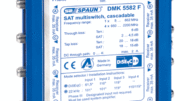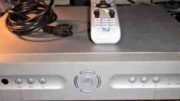Look, some days you get bored. I know. It’s raining outside and you’ve scrolled through the Netflix list like a million times. You start looking around for something entertaining, and you start wondering. Then you start Googling. And then you express surprise when you can’t find the answer to something. And that, my friends, was the beginning of this particular article, when a friend of mine asked me the very question you see above you.
The back of a DIRECTV box

This is the back of a DIRECTV H25. Or, rather, it’s a computer-generated rendering of one. I have actual photos, but this one will do because if nothing else, it’s big enough and sharp enough to show you what I’m talking about. Take a look at this connector:

It’s nestled right in there between RCA connectors that you probably know about and HDMI connectors that you probably know about. They call it A/V OUT, but there’s really no understanding of why it’s there. Well, buckle up my friends, you’re about to find out.
11-1 Pin Mini DIN
There, you know as much as you did before, right? It’s an 11-1Pin Mini DIN. That is to say, it follows the Mini DIN standard format of a connector that’s round with a flat spot on top. It would have 11 holes, but 1 of them is covered up. But this doesn’t tell you what it’s really there for. This same connector could be used for a lot of different things, and it probably has. In order to understand why it’s there and what you can do with it, you need to understand the thinking that was going through DIRECTV in the early ’10s.
Flash back to 2010
In 2010, DIRECTV was the unquestioned leader in pay-TV. Profits and subscriber numbers were up every quarter. Streaming? No one did that. No one even knew what it was. Satellite TV, baby. That’s where it was at. With that kind of environment, DIRECTV had the money to really develop new hardware to meet customer needs. They could also focus on making new stuff that was easier to support.
When designing the latest generation of receivers, they listened to customers. Customers wanted something quiet and small. In the ’90s, customers wanted as many outputs as possible, but modern customers were willing to give up a few connectors in exchange for something that wouldn’t take up space on a dresser. At the same time, technicians had identified the power supply as the major source of failure on these boxes. All the designs of the 2010s were created to deal with these two concerns.
First, they took the power supply out of the receiver and made it a wall wart. This was the beginning of the ubiquitous EPS10 power supply. Then they looked at the back of the receivers to see what could be removed. To start with, they ditched the component outputs. Practically no one used component since HDMI was introduced. Eventually, they ditched everything but HDMI and one audio output.
But, they realized that there would still be some “cold dead hands” folks who needed to connect their new boxes to antiquated equipment. They needed a solution.
The A/V Out connector
The decision was made to offer a small connector on the back of receivers and client boxes for backwards compatibility. In one small package, they could offer analog audio, composite video, and component video for those folks who had older televisions. This way they didn’t need eight RCA connectors in order to do the same thing. The receivers and client boxes could be smaller, and I have to imagine there was some small cost savings but I don’t think that was the real concern.
How to use it
It’s pretty simple. If you need a composite connection, get this cable. The component cable is out of manufacture, but I think we have a few in the back if you need one. You would want to call us.
Realistically, it’s 2022 and people rarely need to connect up a TV made in the 1990s anymore. But it does happen, and when it does, this cable lets you do it.
Solid Signal Can Help!
Whether it’s getting an old cable or setting yourself up with the most modern possible equipment, Solid Signal can do it all! Shop our great selection of tens of thousands of parts and you’ll find the exact same parts used by major manufacturers, even DIRECTV. We have the things no one else does, all at a fair price and all available for you! If you can’t find what you need or if you need extra help, call us! We’re here during East Coast business hours to serve you. Call 888-233-7563 to talk to the experts. If it’s after hours, fill out the form below and we’ll get back to you, usually within one business day.





